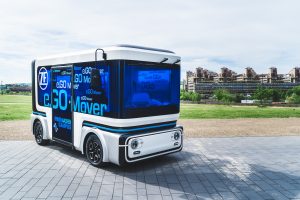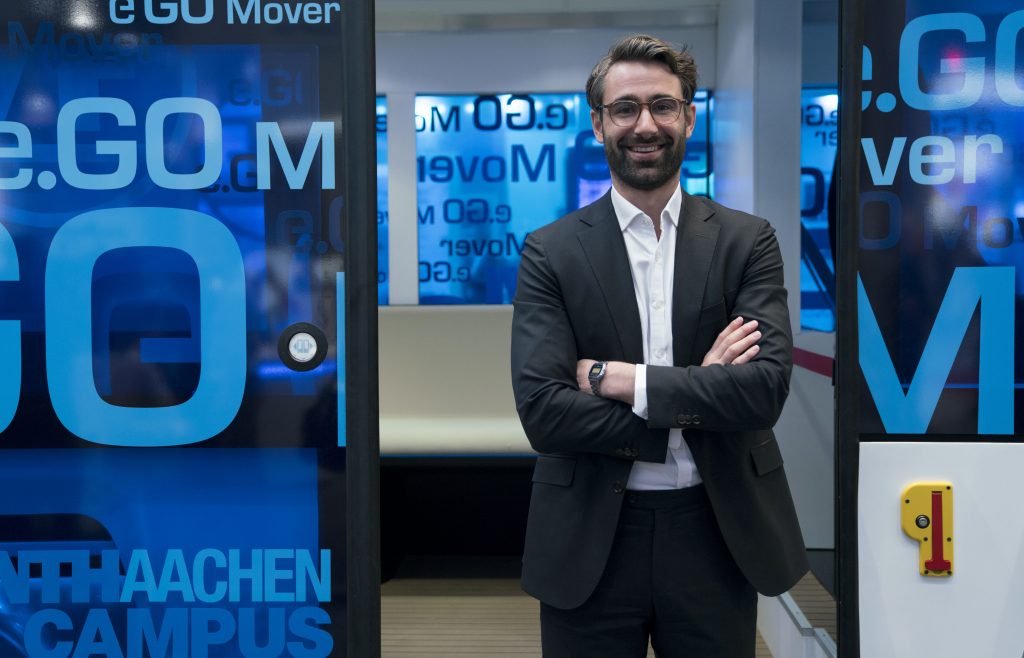Street smart: The e.GO Mover offers a bus for our time
The vision: cleaner air, quieter cities and more money in your pocket. The solution: a minibus.
But this is unlike any bus you’ve ridden before.
The e.GO Mover – a self-driving, electrically powered, cloud-connected vehicle – can transport as many as 10 people sitting plus five standing, making on-demand pickups and drop-offs in urban areas while running on a battery that can last up to 10 hours and span up to 100 miles.
A German company, e.GO Digital is using Microsoft Azure to enable the autonomous shuttle – currently a prototype – to drive safely and smartly in thick traffic. (e.GO Digital is a subsidiary of e.GO Mobile, the German startup that manufactures the minibus.)
At Hannover Messe, Casimir Ortlieb, CEO and co-founder of e.GO Digital, described to Transform how he sees a fleet of these smart minibuses remaking the way people get around the big city – potentially improving city life itself.
TRANSFORM: When and where will the e.GO Mover hit the streets?
CASIMIR ORTLIEB: The beginning of 2019.
We’re planning to showcase it in three cities: Aachen, in western Germany, where we manufacture the bus; Munich, because we think that will be a nice place to show what the Mover can do; and Friedrichshafen, in southern Germany, home to one of our main partners, ZF, a systems supplier.

TRANSFORM: How much could a network of electric e.GO Movers potentially reduce CO2 emissions caused by the traditional buses, trucks and cars people use to traverse cities?
ORTLIEB: Our greater vision is to one day have traffic-free inner cities, maybe equipped only with electrical vehicles that people drive in a shared system with electrical buses that work on demand.
How much that system reduces CO2 emissions of course depends on the scale. We see a stepped approach to get there. In the first step, cities may use e.GO Movers in parallel with their public transportation. In the second step, they may change their public transportation to all electrical buses.
Cities are thinking about concepts to become emission free or to lower CO2 emissions. In our vision of mobility, a city that makes these changes maybe no longer has any carbon emissions from vehicles.
TRANSFORM: A traffic-free city also sounds like a much safer place for drivers, riders and pedestrians.
ORTLIEB: Definitely. We think that the technology is capable of making transportation or mobility safer.
It will take some time. We have to train the algorithms and the artificial intelligence that allows that. But one day, I’m sure that this will provide a more secure way of traveling.
TRANSFORM: Beyond shuttling people from A to B, what other commercial uses do you foresee for the e.GO Mover?
ORTLIEB: We have a completely modular building structure – with easy adaptions, we can change the look of the bus. That means we have, right now, 10 different use cases that we can imagine – from people transportation to cargo transportation to maybe even a restaurant that is moving around.
TRANSFORM: A small, mobile restaurant? Like a cloud-connected food cart?
ORTLIEB: Exactly. That’s one idea. Like a little Italian bistro that’s moving around.
TRANSFORM: Yum. And could incorporating Azure help drive down or even eliminate the cost of riding the e.GO Mover?
ORTLIEB: e.GO Digital is building different digital business models around the Mover. For example, imagine that advertisements of local businesses can be displayed on the bus. We need a platform to manage that.
So yes, other players could finance mobility. Maybe it’s financed by local shops that display their advertisements on the windows of buses in augmented reality. We think that with that technology, mobility could be far more affordable or even free of charge.
Top image: Casimir Ortlieb. (Photo by Cyrus Cambridge, Edelman)








